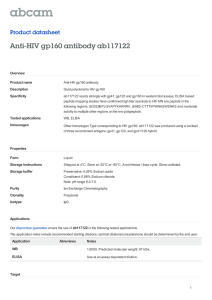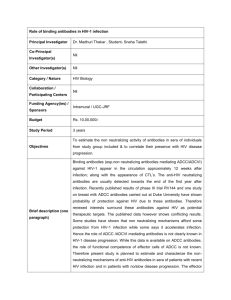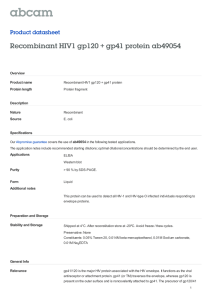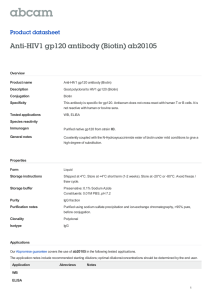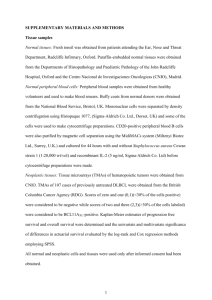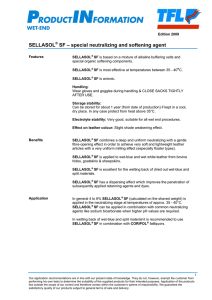J V , Dec. 1996, p. 9046–9050 Vol. 70, No. 12
advertisement
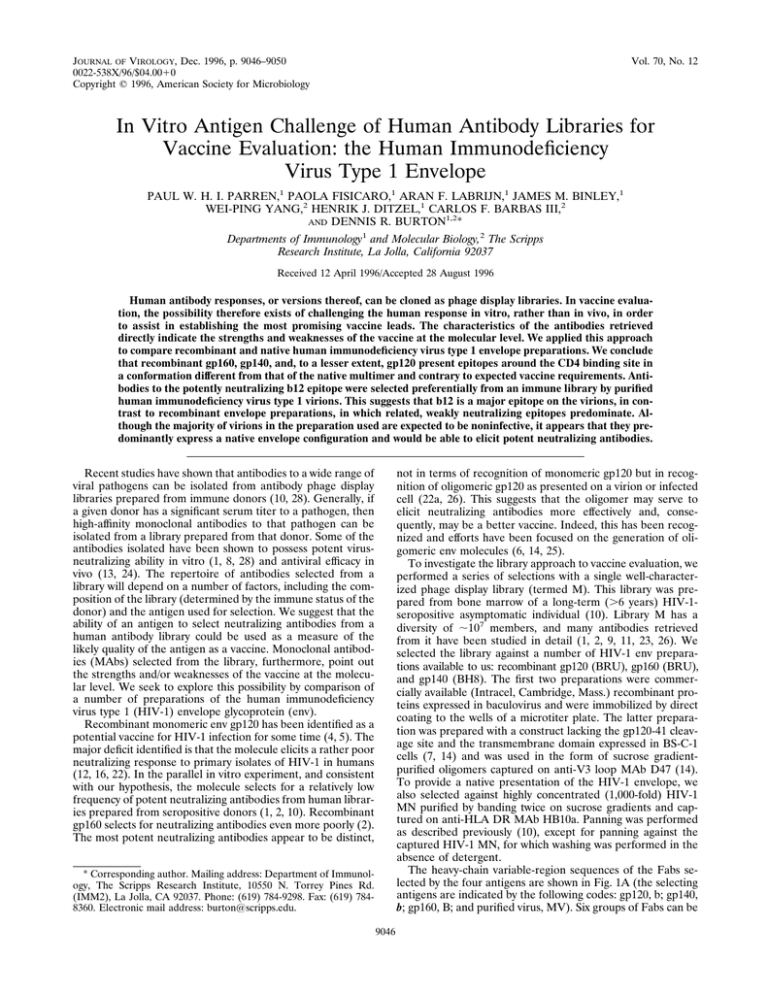
JOURNAL OF VIROLOGY, Dec. 1996, p. 9046–9050 0022-538X/96/$04.0010 Copyright q 1996, American Society for Microbiology Vol. 70, No. 12 In Vitro Antigen Challenge of Human Antibody Libraries for Vaccine Evaluation: the Human Immunodeficiency Virus Type 1 Envelope PAUL W. H. I. PARREN,1 PAOLA FISICARO,1 ARAN F. LABRIJN,1 JAMES M. BINLEY,1 WEI-PING YANG,2 HENRIK J. DITZEL,1 CARLOS F. BARBAS III,2 1,2 AND DENNIS R. BURTON * Departments of Immunology1 and Molecular Biology,2 The Scripps Research Institute, La Jolla, California 92037 Received 12 April 1996/Accepted 28 August 1996 Human antibody responses, or versions thereof, can be cloned as phage display libraries. In vaccine evaluation, the possibility therefore exists of challenging the human response in vitro, rather than in vivo, in order to assist in establishing the most promising vaccine leads. The characteristics of the antibodies retrieved directly indicate the strengths and weaknesses of the vaccine at the molecular level. We applied this approach to compare recombinant and native human immunodeficiency virus type 1 envelope preparations. We conclude that recombinant gp160, gp140, and, to a lesser extent, gp120 present epitopes around the CD4 binding site in a conformation different from that of the native multimer and contrary to expected vaccine requirements. Antibodies to the potently neutralizing b12 epitope were selected preferentially from an immune library by purified human immunodeficiency virus type 1 virions. This suggests that b12 is a major epitope on the virions, in contrast to recombinant envelope preparations, in which related, weakly neutralizing epitopes predominate. Although the majority of virions in the preparation used are expected to be noninfective, it appears that they predominantly express a native envelope configuration and would be able to elicit potent neutralizing antibodies. not in terms of recognition of monomeric gp120 but in recognition of oligomeric gp120 as presented on a virion or infected cell (22a, 26). This suggests that the oligomer may serve to elicit neutralizing antibodies more effectively and, consequently, may be a better vaccine. Indeed, this has been recognized and efforts have been focused on the generation of oligomeric env molecules (6, 14, 25). To investigate the library approach to vaccine evaluation, we performed a series of selections with a single well-characterized phage display library (termed M). This library was prepared from bone marrow of a long-term (.6 years) HIV-1seropositive asymptomatic individual (10). Library M has a diversity of ;107 members, and many antibodies retrieved from it have been studied in detail (1, 2, 9, 11, 23, 26). We selected the library against a number of HIV-1 env preparations available to us: recombinant gp120 (BRU), gp160 (BRU), and gp140 (BH8). The first two preparations were commercially available (Intracel, Cambridge, Mass.) recombinant proteins expressed in baculovirus and were immobilized by direct coating to the wells of a microtiter plate. The latter preparation was prepared with a construct lacking the gp120-41 cleavage site and the transmembrane domain expressed in BS-C-1 cells (7, 14) and was used in the form of sucrose gradientpurified oligomers captured on anti-V3 loop MAb D47 (14). To provide a native presentation of the HIV-1 envelope, we also selected against highly concentrated (1,000-fold) HIV-1 MN purified by banding twice on sucrose gradients and captured on anti-HLA DR MAb HB10a. Panning was performed as described previously (10), except for panning against the captured HIV-1 MN, for which washing was performed in the absence of detergent. The heavy-chain variable-region sequences of the Fabs selected by the four antigens are shown in Fig. 1A (the selecting antigens are indicated by the following codes: gp120, b; gp140, b; gp160, B; and purified virus, MV). Six groups of Fabs can be Recent studies have shown that antibodies to a wide range of viral pathogens can be isolated from antibody phage display libraries prepared from immune donors (10, 28). Generally, if a given donor has a significant serum titer to a pathogen, then high-affinity monoclonal antibodies to that pathogen can be isolated from a library prepared from that donor. Some of the antibodies isolated have been shown to possess potent virusneutralizing ability in vitro (1, 8, 28) and antiviral efficacy in vivo (13, 24). The repertoire of antibodies selected from a library will depend on a number of factors, including the composition of the library (determined by the immune status of the donor) and the antigen used for selection. We suggest that the ability of an antigen to select neutralizing antibodies from a human antibody library could be used as a measure of the likely quality of the antigen as a vaccine. Monoclonal antibodies (MAbs) selected from the library, furthermore, point out the strengths and/or weaknesses of the vaccine at the molecular level. We seek to explore this possibility by comparison of a number of preparations of the human immunodeficiency virus type 1 (HIV-1) envelope glycoprotein (env). Recombinant monomeric env gp120 has been identified as a potential vaccine for HIV-1 infection for some time (4, 5). The major deficit identified is that the molecule elicits a rather poor neutralizing response to primary isolates of HIV-1 in humans (12, 16, 22). In the parallel in vitro experiment, and consistent with our hypothesis, the molecule selects for a relatively low frequency of potent neutralizing antibodies from human libraries prepared from seropositive donors (1, 2, 10). Recombinant gp160 selects for neutralizing antibodies even more poorly (2). The most potent neutralizing antibodies appear to be distinct, * Corresponding author. Mailing address: Department of Immunology, The Scripps Research Institute, 10550 N. Torrey Pines Rd. (IMM2), La Jolla, CA 92037. Phone: (619) 784-9298. Fax: (619) 7848360. Electronic mail address: burton@scripps.edu. 9046 VOL. 70, 1996 NOTES 9047 FIG. 1. (A) The heavy-chain sequences of the Fabs retrieved from panning phage display library M against recombinant gp120 (b), gp160 (B), gp140 (b), and purified, highly concentrated HIV-1 MN virions (MV). The Fabs are organized into six groups of Fabs with similar sequences. (B) The frequency of Fabs from each sequence group, indicated by the prototype Fab, after selecting the library for four rounds of panning against the antigen indicated. identified on the basis of their heavy-chain sequences, as shown previously for gp120 and gp160 (2). All of these Fabs are directed to epitopes overlapping the gp120 CD4 binding site (CD4bs). The differences among the antibodies within each group can most probably be attributed to somatic mutation, although it cannot be ruled out that some mutations were introduced by the PCR cloning procedure used for library preparation. The frequencies with which these Fabs were retrieved from the library after four rounds of panning are indicated in Fig. 1B. Recombinant gp120 and, in particular, recombinant gp140 and gp160 do not or only poorly select for potent neutralizing antibodies. In contrast, native env, as present on purified, highly concentrated HIV-1 MN virus, selected strongly for antibodies to the potently neutralizing b12 epitope. This suggests that b12 is a major epitope on these virions, as opposed to the recombinant env preparation tested, in which related, weakly neutralizing epitopes predominate. The result also indicates that although the majority of virions in the preparation used are expected to be noninfective (20), it appears that they predominantly express a native env configuration. The selections described above were performed with an immune phage display library composed of ;107 individual clones, and although well characterized, the exact composition is therefore unknown. To investigate the library approach to vaccine evaluation in a more controlled system, we performed a series of selections by using a minilibrary. This minilibrary consisted of only four different phages, displaying well-characterized CD4bs-specific Fabs with differing HIV-1 neutralizing ability. The library included the potent neutralizing Fab b12, the intermediate neutralizer b11, and the weakly neutralizing Fabs b3 and b6 (1, 10, 11). Selections were carried out against recombinant gp120, gp160, and gp140. To provide a native presentation of env, we included cells infected with laboratory strain HIV-1 MN or IIIB. Equal amounts of the four different phages were pooled and selected in one round of panning. Unbound phage was removed by washing 10 times by vigorous pipetting, with a 5-min incubation between washes, as described previously (10). Panning on the infected H9 cells was performed by incubating cells and phage in culture medium for 2 h at 378C. Unbound phage was removed by spinning and resuspending the cells 10 9048 NOTES FIG. 2. A minilibrary containing equal amounts of four different anti-gp120 CD4bs Fabs (b6, b3, b11, and b12) displayed on phage was prepared. (A) The library was panned against the five HIV-1 env preparations indicated, and the representation of the clones was determined. Selection was carried out against either immobilized antigen (recombinant gp120, gp140, and gp160) or against live infected (Inf.) cells (H9 infected with HIV-1 MN or IIIB). gp120 and gp160 were coated directly on the plate, and gp140 was captured on V3 loop MAb D47. Approximately 20 clones were screened for the data shown in each bar. (B) The library was panned against coated gp120 or gp120 captured on MAb D47 or a sheep antibody (D7234) against the C terminus of gp120. Ten clones were screened for the data represented in each bar. times, with a 5-min incubation between washes as described above. The composition of the minilibrary before and after panning was checked by performing DNA miniprep analysis on ;20 clones, and the results are plotted in Fig. 2A. Panning against gp120 produced a positive selection for b6 and a neutral to somewhat negative selection for b12, b11, and b3, with some small variation in absolute numbers between experiments (Fig. 2). However, most Fab b12 phage were lost after panning against gp140 or gp160. These preparations selected Fab b6 even more strongly. In contrast, there was strong enrichment of Fab b12 phage after panning against IIIB- or MN-infected H9 cells presenting native env. In another experiment, we skewed the library composition towards b6 (90% b6, 5% b3, ,5% b11, and 5% b12). Also, in this experiment, a strong selection for b12 was found after panning for one round J. VIROL. against HIV-1 IIIB-infected cells (the final composition was 55% b6, 10% b3, 10% b11, and 25% b12). These data suggest an efficient presentation of the b12 epitope on native env and are in agreement with the selection experiments using the immune library and concentrated virus as antigen. Panning of the minilibrary against the purified HIV-1 MN virus also showed very strong selection for b12 phage (data not shown). Differences between the frequencies of Fabs b3 and b6 after selection of the immune or minilibrary are probably due to differences in the frequencies with which these clones are present in the unselected libraries. Figure 1A shows that b6 Fabs are selected less frequently than b3 Fabs, although the affinity of Fab b6 for gp120 and gp140 is slightly higher than that of b3 (Table 1), suggesting an underrepresentation of b6 in library M. The poor selection of neutralizing antibody by recombinant gp140 was disappointing considering that the construct expressing soluble gp140 oligomer was prepared in order to obtain a more native presentation of recombinant HIV-1 env. The results from the selection of library M and the minilibrary were further confirmed by selecting a number of other antibody phage display libraries prepared from long-term asymptomatic donors. Also, in these experiments, gp140 selected only for weakly or nonneutralizing antibodies (data not shown). One possible explanation for these observations was that the capture of gp140 with anti-V3 MAb perturbs the CD4bs epitope. A control experiment examining the binding of b12 and other CD4bs Fabs to gp120 argued against this interpretation, however (Fig. 2B). The minilibrary was selected against coated gp120, gp120 captured on MAb D47, and gp120 captured on anti-C-terminal D7234 sheep antibody (Aalto BioReagents, Dublin, Ireland). Selection against gp120 in all three presentations yielded similar results, indicating that capture on the V3 loop did not affect the relative affinity for gp120 of the panel of CD4bs antibodies used. BIAcore affinity data obtained with the gp140 preparation chemically cross-linked to the sensor chip (see below), furthermore, also confirm the panning results. It is therefore unlikely that the mode of capture of gp140 strongly affected the outcome of the panning experiment. To understand the results of the panning experiments, we studied the binding of a panel of Fabs to recombinant gp120 and gp140 with surface plasmon resonance as shown in Table 1. Both proteins were covalently linked to the sensor chip by using amine coupling chemistry (Pharmacia Biosensor, Uppsala, Sweden). The gp140 preparation used for immobilization was purified by lentil lectin chromatography, as described previously, and contains a mixture of oligomers and a minor fraction of monomeric material (14). As controls, we measured the TABLE 1. Affinity constants of recombinant Fab for gp120 and gp140 Fab or MAb Fab Fab Fab Fab Fab Fab b6 b14 b3 b13 b11 b12 Fab 3B3 sCD4 MAb T4 Ka (M21) for: gp120 gp140 Ka ratio (gp140/gp120) 9.7 3 107 9.2 3 107 5.1 3 107 7.9 3 107 1.3 3 108 1.1 3 108 5 3 109 4.3 3 108 1.8 3 109 6.7 3 108 6.2 3 108 1.1 3 108 51 4.7 35 8.4 4.8 1 1.3 3 109 1.6 3 108 No binding 1.3 3 109 2.8 3 108 2 3 109 1 1.8 VOL. 70, 1996 FIG. 3. The ratio of the affinity constants (Ka) for recombinant gp140 and gp120 was determined for each Fab and plotted against its 50% neutralization titer, which was measured in an env complementation assay using HIV-1 molecular clone HxBc2 (see reference 26). The affinity constants were obtained from kinetic data measured with BIAcore. binding of soluble CD4, which has a similar affinity for gp120 and gp140, as reported previously (6), and MAb T4, which binds to oligomer specifically. In contrast to recombinant gp120, for which the members of the Fab panel had similar affinities, large differences in affinity for the gp140 preparation were observed among the Fabs. The Fabs in Table 1 are arranged in order of neutralizing potency (26). Weakly neutralizing Fabs, e.g., Fab b6, show the highest apparent affinity for gp140, and the strongest neutralizing antibodies, e.g., Fab b12, show the weakest affinities. Indeed, the Ka gp140/Ka gp120 ratio for an Fab is approximately inversely related to neutralizing ability, as shown in Fig. 3, where the Ka ratio is plotted against the 50% neutralization titer measured in an HIV-1 clone HxBc2 env complementation assay (17, 26). This correlation is also maintained with the in vitro-improved b12 variant 3B3 (3). Therefore, the preferential selection of weakly neutralizing Fabs on gp140 can be understood in terms of the higher affinity of these Fabs for this protein. In contrast, the weakly neutralizing Fabs bind less well to native env on gp120 env-transfected and HIV-1-infected cells (22a, 26), and strongly neutralizing Fab b12 is preferentially selected. We were unable to evaluate binding to recombinant gp160 by surface plasmon resonance as this preparation immobilized only poorly on the sensor chip. In conclusion of the present HIV-1 envelope evaluation, the library approach predicts a vaccine efficacy ranking, at least with regard to the presentation of the important CD4bs epitope and the preparations used, in the order native env . recombinant gp120 . recombinant gp160 and gp140. There is some support for this rank order from results of human vaccine trials. Recombinant gp160 has generally been shown to be less effective than gp120 in inducing neutralizing antibodies against homologous HIV-1 laboratory strains (15). Neither HIV-1 envelope preparation, furthermore, induced neutralizing antibodies against primary isolates of HIV-1 (12, 16, 21). In apparent contradiction to our study, VanCott et al. (27) have suggested that gp160 is a better mimic of HIV-1 env than is gp120 for vaccine purposes, since gp160 was found to be approximately fivefold more reactive with HIV-1 patient sera than monomeric gp120. gp160 was purified in an oligomeric form from chronically infected cells shown to secrete fulllength unprocessed molecules (18, 19). The results presented NOTES 9049 here suggest that the higher reactivity of gp160 probably results from a higher affinity of weakly neutralizing CD4bs antibodies (which constitute the majority of the response). Overall, it would appear that oligomerization of unprocessed soluble gp160 or gp140 does not lead to a more native presentation of HIV-1 env. The strong serum reactivity with unprocessed gp160 further implies that the immune response to HIV-1 is focused more on viral debris than on virus or virally infected cell surfaces. Clearly, our methodology does not give any information about immunogenicity or clearance of vaccines in vivo. We anticipate, however, that new oligomer preparations which will be widely evaluated, including by library selection, will now be forthcoming. Positive findings from the library approach would indicate favorable presentation of neutralizing epitopes to the humoral human anti-HIV-1 response, which would strongly encourage in vivo evaluation. Furthermore, the nature of the antibodies selected would highlight the strengths and weaknesses of the multimer as a vaccine. What advantages does the library approach offer in the evaluation of a vaccine compared with, for example, simply measuring the ability of a panel of existing antibodies to bind the vaccine in question? First, with the library approach, it is unnecessary to have any a priori knowledge of the antibodies selected; after several rounds of panning, a polyclonal preparation of Fabs may be prepared and tested for neutralizing ability. In this study, we deliberately chose a well-characterized system. Normally such detailed information on the antibodies would not be so readily available. Second, the antigen preparation may select for totally new antibodies against previously uncharacterized epitopes. The approach then leads directly to MAbs of great interest. Third, during the selection of the library, antibodies may bind simultaneously to distinct epitopes as in an in vivo situation, in which, for example, synergies and induced conformational changes may play a role. Fourth, information is obtained directly on human antibodies reacting with the vaccine; murine antibodies commonly available may reflect peculiarities of immunization in the animal model. In summary, the presence of antibodies against overlapping epitopes with varying neutralizing ability in a phage display library mimics the in vivo situation. The immune repertoire can then be challenged in vitro by selecting the library against a potential vaccine. For a good vaccine, neutralizing epitopes should be presented most favorably, leading to selection of neutralizing antibodies. The characteristics of the antibodies retrieved from the library are indicators of the integrity of the vaccine at the molecular level. This work was supported by National Institutes of Health grants AI33292 and AI37470. P.W.I.P. is supported by a Scholarship Award from the Pediatric AIDS Foundation (award number 77290-20-PF). C.F.B. acknowledges an Investigator Award from the Cancer Research Institute. P.F. was supported by an AIDS fellowship from the Istituto Superiore di Sanita, Italy. The following reagents were obtained through the AIDS Research and Reference Reagent Program, Division of AIDS, NIAID, National Institutes of Health: recombinant soluble CD4 (from R. Sweet), H9 cells, and HIV-1 IIIB strain (from R. Gallo). We are grateful to Bernard Moss, Patricia Earl, and Robert Doms for providing recombinant gp140 and MAbs T4 and D47 and to Lynette Sawyer for providing HIV-1 MN. The highly concentrated purified HIV-1 MN was kindly provided by Larry Arthur. We thank Tom VanCott for helpful advice with the BIAcore experiments and Meng Wang for his contribution to this work. REFERENCES 1. Barbas, C. F., III, E. Bjorling, F. Chiodi, N. Dunlop, D. Cababa, T. M. Jones, S. L. Zebedee, M. A. Persson, P. L. Nara, E. Norrby, and D. R. Burton. 1992. 9050 2. 3. 4. 5. 6. 7. 8. 9. 10. 11. 12. 13. 14. NOTES Recombinant human Fab fragments neutralize human type 1 immunodeficiency virus in vitro. Proc. Natl. Acad. Sci. USA 89:9339–9343. Barbas, C. F., III, T. A. Collet, W. Amberg, P. Roben, J. M. Binley, D. Hoekstra, D. Cababa, T. M. Jones, R. A. Williamson, G. R. Pilkington, N. L. Haigwood, E. Cabezas, A. C. Satterthwait, I. Sanz, and D. R. Burton. 1993. Molecular profile of an antibody response to HIV-1 as probed by combinatorial libraries. J. Mol. Biol. 230:812–823. Barbas, C. F., III, D. Hu, N. Dunlop, L. Sawyer, D. Cababa, R. M. Hendry, P. L. Nara, and D. R. Burton. 1994. In vitro evolution of a neutralizing human antibody to human immunodeficiency virus type 1 to enhance affinity and broaden strain cross-reactivity. Proc. Natl. Acad. Sci. USA 91:3809– 3813. Berman, P. W., D. J. Eastman, D. M. Wilkes, G. R. Nakamura, T. J. Gregory, D. Schwartz, G. Gorse, R. Belshe, M. L. Clements, and R. A. Byrn. 1994. Comparison of the immune response to recombinant gp120 in humans and chimpanzees. AIDS 8:591–601. Berman, P. W., T. J. Gregory, L. Riddle, G. R. Nakamura, M. A. Champe, J. P. Porter, F. M. Wurm, R. D. Hershberg, E. K. Cobb, and J. W. Eichberg. 1990. Protection of chimpanzees from infection by HIV-1 after vaccination with recombinant glycoprotein gp120 but not gp160. Nature (London) 345: 622–625. Berman, P. W., L. Riddle, G. Nakamura, O. K. Haffar, W. M. Nunes, P. Skehel, R. Byrn, J. Groopman, T. Matthews, and T. Gergory. 1989. Expression and immunogenicity of the extracellular domain of the human immunodeficiency virus type 1 envelope glycoprotein, gp160. J. Virol. 63:3489– 3498. Broder, C. C., P. L. Earl, D. Long, S. T. Abedon, B. Moss, and R. W. Doms. 1994. Antigenic implications of human immunodeficiency virus type 1 envelope quaternary structure: oligomer-specific and -sensitive monoclonal antibodies. Proc. Natl. Acad. Sci. USA 91:11699–11703. Burioni, R., R. A. Williamson, P. P. Sanna, F. E. Bloom, and D. R. Burton. 1994. Recombinant human Fab to glycoprotein D neutralizes infectivity and prevents cell-to-cell transmission of herpes simplex viruses 1 and 2 in vitro. Proc. Natl. Acad. Sci. USA 91:355–359. Burton, D. R., and C. F. Barbas III. 1994. Human antibodies from combinatorial libraries. Adv. Immunol. 57:191–280. Burton, D. R., C. F. Barbas III, M. A. Persson, S. Koenig, R. M. Chanock, and R. A. Lerner. 1991. A large array of human monoclonal antibodies to type 1 human immunodeficiency virus from combinatorial libraries of asymptomatic seropositive individuals. Proc. Natl. Acad. Sci. USA 88:10134–10137. Burton, D. R., J. Pyati, R. Koduri, S. J. Sharp, G. B. Thornton, P. W. H. I. Parren, L. S. W. Sawyer, R. M. Hendry, N. Dunlop, P. L. Nara, M. Lamacchia, E. Garratty, E. R. Stiehm, Y. J. Bryson, Y. Cao, J. P. Moore, D. D. Ho, and C. F. Barbas III. 1994. Efficient neutralization of primary isolates of HIV-1 by a recombinant human monoclonal antibody. Science 266:1024– 1027. Cohen, J. 1993. Jitters jeopardize AIDS vaccine trials. Science 262:980–981. Crowe, J. E., Jr., R. M. Murphy, R. M. Chanock, R. A. Williamson, C. F. Barbas III, and D. R. Burton. 1994. Recombinant human RSV monoclonal antibody Fab is effective therapeutically when introduced directly into the lungs of respiratory synctial virus-infected mice. Proc. Natl. Acad. Sci. USA 91:1386–1390. Earl, P. L., C. C. Broder, D. Long, S. A. Lee, J. Peterson, S. Chakrabarti, R. W. Doms, and B. Moss. 1994. Native oligomeric human immunodeficiency virus type 1 envelope glycoprotein elicits diverse monoclonal antibody reactivities. J. Virol. 68:3015–3026. J. VIROL. 15. Graham, B. S. 1994. Serological responses to candidate AIDS vaccines. AIDS Res. Hum. Retroviruses 10(Suppl. 2):S145–S148. 16. Hanson, C. V. 1994. Measuring vaccine-induced HIV neutralization: report of a workshop. AIDS Res. Hum. Retroviruses 10:645–648. 17. Helseth, E., M. Kowalski, D. Gabuzda, U. Olshevsky, W. Haseltine, and J. Sodroski. 1990. Rapid complementation assays measuring replicative potential of human immunodeficiency virus type 1 envelope glycoprotein mutants. J. Virol. 64:2416–2420. 18. Kalyanaraman, V., R. Pal, R. C. Gallo, and M. G. Sarngadharan. 1988. A unique human immunodeficiency virus culture secreting soluble gp160. AIDS Res. Hum. Retroviruses 4:319–329. 19. Kalyanaraman, V., V. Rodriguez, F. Veronese, R. Rahman, P. Lusso, A. L. Devico, T. Copeland, S. Oroszlan, R. C. Gallo, and M. G. Sarngadharan. 1990. Characterization of the secreted, native gp120 and gp160 of the human immunodeficiency virus type 1. AIDS Res. Hum. Retroviruses 6:371–380. 20. Layne, S. P., M. J. Merges, M. Dembo, J. L. Spouge, S. R. Conley, J. P. Moore, J. L. Raina, H. Renz, H. R. Gelderblom, and P. L. Nara. 1992. Factors underlying spontaneous inactivation and susceptibility to neutralization of human immunodeficiency virus. Virology 189:695–714. 21. Mascola, J. R., S. W. Snyder, O. S. Weislow, S. M. Belay, R. B. Belshe, D. H. Schwartz, M. L. Clements, R. Dolin, B. S. Graham, G. J. Gorse, M. C. Keefer, M. J. McElrath, M. C. Walker, K. F. Wagner, J. G. McNeil, F. E. McCutchan, and D. S. Burke. 1996. Immunization with envelope subunit vaccine products elicits neutralizing antibodies against laboratory-adapted but not primary isolates of human immunodeficiency virus type 1. J. Infect. Dis. 173:340–348. 22. Matthews, T. J. 1994. Dilemma of neutralization resistance of HIV-1 field isolates and vaccine development. AIDS Res. Hum. Retroviruses 10:631– 632. 22a.Parren, P. W. H. I., D. Naniche, J. P. Moore, D. R. Burton, and Q. Sattentau. 1996. Unpublished data. 23. Parren, P. W. H. I., and D. R. Burton. 1997. Antibodies against HIV-1 from phage display libraries: mapping of an immune response and progress towards anti-viral immunotherapy, p. 18–56. In J. D. Capra (ed.), Antibody engineering chemical immunology, vol. 65. S. Karger AG, Basel. 24. Parren, P. W. H. I., H. J. Ditzel, R. J. Gulizia, J. M. Binley, C. F. Barbas III, D. R. Burton, and D. E. Mosier. 1995. Protection against human immunodeficiency virus type 1 infection in hu-PBL-SCID mice by passive immunization with a neutralizing human monoclonal antibody against the gp120 CD4-binding site. AIDS 9:F1–F6. 25. Pasquali, J. L., M. P. Kieny, H. Kolbe, D. Christmann, and A. M. Knap. 1990. Immunogenicity and epitope mapping of a recombinant soluble gp160 of the human immunodeficiency virus type 1 envelope glycoprotein. AIDS Res. Hum. Retroviruses 6:1107–1113. 26. Roben, P., J. P. Moore, M. Thali, J. Sodroski, C. F. Barbas III, and D. R. Burton. 1994. Recognition properties of a panel of human recombinant Fab fragments to the CD4 binding site of gp120 that show differing abilities to neutralize human immunodeficiency virus type 1. J. Virol. 68:4821–4828. 27. VanCott, T. C., S. C. D. Veit, V. Kalyanaraman, P. Earl, and D. L. Birx. 1995. Characterization of a soluble, oligomeric HIV-1 gp160 protein as a potential immunogen. J. Immunol. Methods 183:103–117. 28. Williamson, R. A., R. Burioni, P. P. Sanna, L. J. Partridge, C. F. Barbas III, and D. R. Burton. 1993. Human monoclonal antibodies against a plethora of viral pathogens from single combinatorial libraries. Proc. Natl. Acad. Sci. USA 90:4141–4145.
